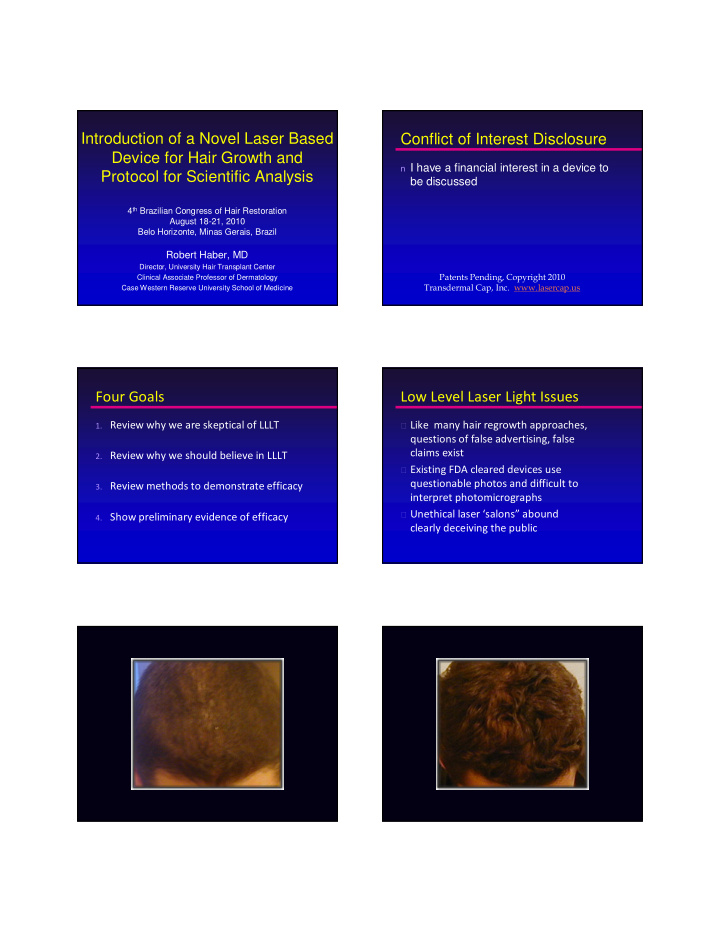



Introduction of a Novel Laser Based Conflict of Interest Disclosure Device for Hair Growth and n I have a financial interest in a device to Protocol for Scientific Analysis be discussed 4 th Brazilian Congress of Hair Restoration August 18-21, 2010 Belo Horizonte, Minas Gerais, Brazil Robert Haber, MD Director, University Hair Transplant Center �������������������������������� Clinical Associate Professor of Dermatology ����������� �������������������������� Case Western Reserve University School of Medicine Four Goals Low Level Laser Light Issues 1. Review why we are skeptical of LLLT � Like many hair regrowth approaches, questions of false advertising, false claims exist 2. Review why we should believe in LLLT � Existing FDA cleared devices use questionable photos and difficult to 3. Review methods to demonstrate efficacy interpret photomicrographs � Unethical laser ‘salons” abound 4. Show preliminary evidence of efficacy clearly deceiving the public
Practical roadblocks to efficacy Practical roadblocks to efficacy � 225 movements in 15 � Less than a third of the HairMax HairMax minutes, once every 4 scalp exposed in 15 seconds minutes � 9 lasers, each � During a one week illuminating perhaps every other day 9mm2 treatment cycle, each mm of the scalp � The scalp measures receives only 4 seconds 600cm2 or 60,000 of laser exposure mm2 Practical roadblocks to efficacy Low Level Laser Light Issues � The laser domes are far � Natural therefore for ethical Laser Dome more logical, with practitioners to stay a safe distance greater coverage and from this new technology, and 107 lasers demand scientifically credible evidence of efficacy � However none have FDA clearance, and there is tremendous inconvenience to the patient to have to visit the clinic so often
Low Level Laser Light Issues Why Believe in LLLT? � However, its not reasonable to expect � Mike Hamblin, PhD, Harvard professor and a greater level of efficacy than photobiology expert: currently offered by FDA approved � “Low level laser therapy has been shown in medications, such as minoxidil and thousands of peer-reviewed publications to finasteride increase cellular survival, proliferation and � No change after long term use by function.” these products is considered a � “LLLT is able to stimulate and preserve hair success, even if not a single new hair follicles in patients with androgenetic alopecia has emerged and other hair loss disorders.” Why Believe in LLLT? The LaserCap � My team set out to develop a superior device � And a growing number of credible with the coverage of a dome, but in a portable physicians worldwide have put their design reputations on the line declaring their personal observations of efficacy The LaserCap The LaserCap � We designed a device that fits in a variety of � The entire target zone is treated throughout hats, is powered by a portable battery pack, the duration of treatment, and the user can and contains 224 lasers perform almost any activity during use, including walking, riding, running, preparing dinner, working, and more
Measures of Efficacy Measures of Efficacy � Photos very difficult to control for hair length � Measurement of hair and style, even if there is no attempt to shaft diameter deceive problematic � Photomicrographs are very difficult to � There is no way to interpret, providing only a tiny snippet of determine if the long hair shaft for evaluation axis or short axis is being measured � Arbitrary visual separation of hairs into terminal and non-terminal hairs allows bias to affect data Measures of Efficacy New Approach � Measuring bundles of � Measurement of individual hair shafts hairs tip to base � Assess changes in diameter and cross sectional area over time � What is normal? Conventional Wisdom Conventional Wisdom
Conventional Wisdom Normal Hair Shaft Change Over Time � Hutchinson PE, Thompson JR. (1994) Hutchinson PE, Thompson JR. The cross-sectional size and shape of human terminal scalp hair. Br J Dermatol. 1997 Feb;136(2):159-65. � Nizzimov, J (2004) Nizzimov, J. ��������������������������������������������������������� ���� � ��!��������"���#��$"#%$&'� � Hair shaft diameter slowly decreases over time, in absence of pattern hair loss Normal Hair Shaft Change Over Time Normal Hair Shaft Change Over Time Hypothesis Hypothesis � An effective treatment modality would reverse this slope � By increasing hair shaft diameter and thus volume, will produce an increase in fullness
Hypothesis Wire scan Spaghetti scan Spaghetti cross sectional area Linguini scan
Linguini cross sectional area Normal Patient Scan Normal Patient Cross Sectional Area Normal Patient 2 Scan Proof of Concept Study Design Normal Patient 2 Cross Sectional Area � Light cap which illuminated only one half of the treatment zone � Worn for 30 minutes every other day � Hair samples were obtained at intervals from the treatment and the control side
Proof of Concept Study Design Control side raw data � Analyze hair shaft segments growing before and after initiating therapy � Determine treatment effect Control side cross sectional area Treatment side raw data Treatment side cross sectional area
Conclusions Conclusions � These preliminary data cannot be used to � We will be evaluating hair shafts from draw conclusions patients who have initiated treatment with minoxidil and finasteride for comparison � They are encouraging however and seem purposes. to support our hypothesis � We hope to begin FDA 510(k) clearance � We are still perfecting the hair shaft trials in the near future evaluation process Thank You! �������������������������������� ����������� ��������������������������
Recommend
More recommend